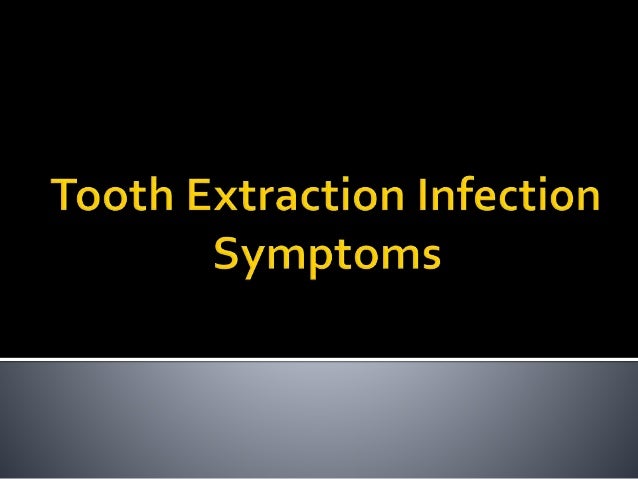Dental Extraction Infection Symptoms

The process of dental extraction, while often necessary for relieving pain and preventing further complications, can sometimes lead to infections. These infections can manifest through a variety of symptoms, which it’s crucial to recognize promptly to ensure appropriate treatment and prevent the infection from worsening. Understanding the signs and symptoms of a dental extraction infection can empower individuals to seek medical attention at the first indication of trouble, thereby facilitating a smoother recovery.
Immediate Post-Extraction Symptoms
Following a dental extraction, it’s normal to experience some discomfort, swelling, and bleeding. However, there are specific symptoms that could indicate the onset of an infection. These include:
- Increased Pain: While some discomfort is expected, a significant increase in pain that doesn’t subside with prescribed pain medication could be a sign of infection.
- Swelling and Redness: Excessive swelling that worsens over time, or redness that spreads beyond the immediate area of the extraction, could indicate an infection.
- Pus or Discharge: The presence of pus or a foul-tasting discharge from the extraction site is a clear sign of infection.
- Fever: Developing a fever, especially if it’s high, can be a sign that your body is fighting an infection.
- Bad Breath: Persistent bad breath that doesn’t improve with good oral hygiene could be a sign of infection.
- Swollen Lymph Nodes: If the lymph nodes in your neck or jaw become swollen and tender, it could indicate that your body is responding to an infection.
Advanced Symptoms
If an infection is left untreated, it can lead to more severe symptoms, including:
- Severe Pain: The pain can become severe and may radiate to other parts of the face or head.
- Abscess Formation: A collection of pus (abscess) may form, which can cause significant pain and swelling.
- Cellulitis: This is a bacterial infection of the skin and tissues beneath. Symptoms include redness, swelling, and warmth of the skin.
- Osteomyelitis: A rare but serious infection of the bone, which can cause deep pain, swelling, and redness.
- Septicemia: In rare cases, the infection can enter the bloodstream, leading to septicemia, a potentially life-threatening condition.
What to Do
If you suspect you have an infection after a dental extraction, it’s essential to contact your dentist or oral surgeon immediately. They may prescribe antibiotics or ask you to come in for an evaluation. In the meantime, there are steps you can take to manage your symptoms:
- Keep the Extraction Site Clean: Rinse gently with warm salt water to keep the area clean and promote healing.
- Manage Pain: Follow the advice of your dentist for managing pain, which may include over-the-counter pain relievers.
- Monitor for Signs of Worsening: Keep an eye on your symptoms and seek immediate medical attention if they worsen or if you develop signs of a more serious infection.
Prevention
While not all infections can be prevented, following your dentist’s instructions post-extraction can significantly reduce the risk. This includes:
- Taking Prescribed Medications: If your dentist prescribes antibiotics, it’s crucial to take the full course as directed.
- Maintaining Good Oral Hygiene: Keeping your mouth clean can help prevent bacteria from accumulating at the extraction site.
- Attending Follow-Up Appointments: Your dentist may want to see you for follow-up appointments to check on the healing process and catch any potential issues early.
In conclusion, recognizing the symptoms of a dental extraction infection is paramount for a successful recovery. By being aware of the signs of infection and taking prompt action, individuals can ensure they receive the necessary treatment to prevent complications and support the healing process. Always prioritize visiting a dental professional if you suspect an infection, as early intervention is key to effective treatment and preventing the spread of infection.
What are the common symptoms of a dental extraction infection?
+Common symptoms include increased pain, swelling and redness, pus or discharge, fever, bad breath, and swollen lymph nodes. These symptoms can vary in severity and may indicate the need for medical attention.
How can I prevent a dental extraction infection?
+Prevention includes following your dentist’s instructions post-extraction, such as taking prescribed medications, maintaining good oral hygiene, and attending follow-up appointments. Keeping the extraction site clean and managing pain as advised can also help reduce the risk of infection.
What should I do if I suspect I have a dental extraction infection?
+If you suspect an infection, contact your dentist or oral surgeon immediately. They may prescribe antibiotics or request that you come in for an evaluation. In the meantime, keep the extraction site clean, manage your pain as advised, and monitor your symptoms for any signs of worsening.

